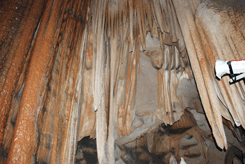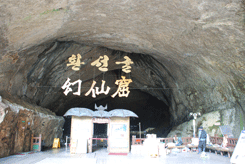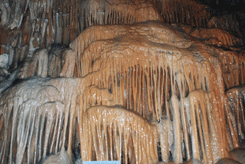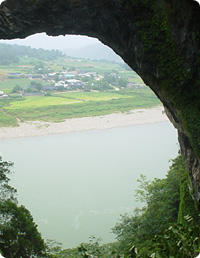Cave
 |
 |
 |
Caves
Caves in Korea are divided primarily into lime grottos and volcanic caves. While lime grottos are found throughout the Korean peninsula, lava caves are found in limited areas, particularly on Jeju Island. Caves have various features which are rarely seen in other geographical settings. Features of cave ceilings include soda straws, stalactites, and curtain-shaped stalactites. Formations on cave floors and cave walls include stone pillars, stalagmites, stalactites, cave coral and lime flowers. More than one thousand caves are in South Korea, most of which are concentrated in the central and northeastern part of Korea including Jeju Island.
Gosu Cave
It is located in Danyang, a city surrounded by mountains and Known as the most beautiful cave in Korea, Gosu cave was formed over 450 million years ago. It contains many stalactites and stalagmites, which are naturally carved in grotesque, intriguing shapes as the result of active erosion and a large quantity of flowing underground water. Rich in speleothem, it is virtually an integrated exhibition hall of all imaginable cave resources. The cave boasts of its natural wonders with its spectacular rock formations such as Lion Head Rock, Seal rock and Walls of heaven including Golden waterfalls and Golden pillar rising 15m high. While it has an entire length of 5.4km, visitors usually explore it up to 1.7km.
Nodong Cave
It is a Danyang's another attraction. Nodong Cave, presumed to have been formed about 500 million years ago, is the Korea's largest vertical cave. The cave is slanted approximately 40-50 degrees. The central part is divided into five branch caves. A hole inside the cave lets in sunlight, so the cave was dubbed the Ilgwang cave (Sunlight cave).
Seongyu Cave
Located in the coastal city of Uljin, it is a lime cave stretches over 472m. A seemingly endless line of stalactites and stalagmites stand inside the cave, which is comprised of 12 small caverns and 5 small ponds. Cavern No. 11 has three naturally-formed Buddha shapes that stand in a queue. Cavern No. 12 has stalactites and stalagmites that look like germ stones.
Hwanseon Cave
It is the largest lime cave on the entire Asian continent. The cave is situated on a mountainside in Dae-ri at approximately 800 meters in elevation. Hwanseon cave mapped in 1967 and is reported to be about 6.2km long, but many cavers still believe that the cave may will be longer than 10km. There are a large number of spleothem and extraordinary stalactites. One can observe the life of cycle of a cave here; its generation, growth, and degradation. In the entrance, many salamanders are living. Several tributary streams merge into one that flows out through the entrance. Many waterfalls are actively eroding the floor; this cave is truly a high-energy cave. Not many speleothems decorate the walls, because Hwanseon Cave is in the initial stage enlargement, but in some places grand flowstone covers whole walls. Also draperies, stalagmites shaped like bald heads, mushroom-shaped flowstones, many rimstones and a huge stalactite called 'Bugaboo's Paddle' are worth seeing. One of the most interesting speleothem is a white rimstone resembling the shape of a 'lotus flower'. It is formed by dripping water and a small white rimstone has developed around the dripping spot. The cave is open to the public about 1.6km long from the entrance.
Yongcheon Cave
Located in Jeju Island. The site includes all the features of both limestone and lava caves, displaying many kinds of lime speleothem including stalactites and anthodites.
Home to a large underground lake, it looks almost like another world.
The discovery of old pottery items also adds to the cave's mysterious history.
Manjang Cave
It is located about 30km east of the Jeju city. It was discovered in 1958. The cave is the most famous tube and has been open to the public since 1976. The inside shows a variety of micro topographic features including flowlines, benches, pahoehoe lava and lava rafts. By far the most marvelous feature is a column that formed during the lava flow from an upper to the lower level and subsequently solidified. This unique double-layered cave is formed by lava flow about 2.5 million years ago. It has known length of 13.4km, and measures 5m wide and varies from 5 to 10m high. In 1970, it was designated as a natural treasure. The cave is a good example for the research and study by naturalists. The bat, centipede, and spider including rare creations are found in this cave. The cave is now open to the public up to 600 meters. On June 27, 2007 UNESCO added this cave to its list of World Heritage sites.
Gimneyong Cave
Neighboring with Manjang cave is Gimnyeong Sagul, meaning the serpent cave, got its name from the sinuous form of the passage, which is as large as that in Manjang Cave. The floor is covered with carbonate sands blown from the nearby beaches. According to the legend, the natives built an altar and sacrifice a teenage girl in the belief that the huge serpent living in this cave would not harm the village and people. When a new governor arrived on the island and learned of this custom. He ordered the people to set up another altar but this time with wine and food. When the reptile appeared the governor stabbed the monster with a spear. Mortally wounded, the serpent disappeared into the sea.
Hyeopjae Ssangyong Cave
Unlike other Jeju lave tube cave, the cave contains numerous carbonate speleothems similar to those found in limestone caves. These caves have been open to the public since 1971. The source of calcium carbonate is rather obvious as the ground above the cave is covered with carbonate sand dunes. It has been said that some parts of the passage were completely filled with the sands. Some large abalone shells have been found the cave. The shell may well be leftover from food that the local people ate and then threw away in the cave long ago. The age of the sand dunes is reported to be about 700-800 years.
Hwanggeum Cave
It is located next to Hyeopjae Cave. It has more diverse carbonate speleothems and also lava speleothems that decorate much of the passage. it is especially interesting that many actively growing soda straws and stalactites are developing along the cracks between the columnar joints in the lava. Also found are palm-sized fossils or abalone shell.
Billemot Cave
It is a 12.4km long lava cave on Jeju Island. It is a sort of Labyrinth cave with a large number of branch caves. Features of the cave include a large stalagmite and a silicic pillar. The lava stalagmite was deemed the world's second largest at 68cm. The silicic pillar, which is 28cm, was formed as a result of silicification. It is exceptionally rare for a silicic pillar to form inside a lava cave. The cave is not open to the public.
Okgye Cave
It is the most seriously scientifically investigated limestone cave. The cave is approximately 750 meters long. It was formed by groundwater corrosion through joints that trend from north to south. After the cave passage was expanded by stream erosion the water table dropped below the cave. Following this there was much collapse. It is a low-energy cave in that some water drops fall only during the rainy season. Various speleothems grow in the cave, including anthodites, helictites, soda straws, stalacities, stalagmites, columns, cave shields, cave corals, flowstones and draperies. In particular, the anthodites of diverse shapes and sizes are distinctive, thus this cave is also called 'cave flower cave'. Huge mud crags are developed near the entrance, and the large size of the mud cracks may be significant worldwide. This sediment is several meters thick and may contain valuable information on the past climatic change on the Korean peninsula.
Dongdae Cave
Situated in Gangneung, it is only 210 meters long and has a very small entrance. Thanks to the difficulty of traversing this narrow entrance the speleothems inside have been beautifully preserved and provide spectacular scenery. In addition to soda straws, stalactites, and stalagmites, many erratic stalactites, cave corals in the pools, and shelfstones magnify the beauty of the cave.
Baengnyong Cave
It is located 15m above the stream and you can only reach the cave by boat because both sides of the cave entrance are cliffs. The cave is about 1.1km long and has three branches. Each cave even more attractive. The lower level includes a vigorously flowing stream, thus it can be considered to be high-energy cave. The upper level has only a few water drops and flowing water during rainy period. Numerous speleothems are still actively growing there. The unique speleothems of Baengnyong Cave include erratic stalactites and stalagmites, a piano stalactite that makes different melodies like a piano if you hit the individual curtains, cave shields and rimstones with beautiful cave popcorn. In particular, numerous fried-egg stalagmites with light yellow centers and white rim make this cave even more interesting.
Ondal Cave
The cave is located near Ondal Mountain Fortress, A stream flows along the main passage. We still do not know exactly how long the cave is because it is not completely explored and mapped. The cave can be considered as a 'young', i.e., high-energy cave that has a vadose passage which is still being eroded and expanded by the stream. Not many speleothems grow in the cave, but there are some stalactites, stalagmites, columns and rimstones found here and there. The most fascinating view is the exposed limestones showing folded stratification partially eroded by the underground stream. Numerous pits corroded by condensed water vapor are another characteristic of this cave.
Cheondong Cave
It is a provincial monument and displays speleothems that are not less charming than in other nearby caves of greater listed importance. The white stalactites and stalagmites that grow in diverse places, rimstones and associated shelf stone, helictites growing on top of stalactites, and anthodites growing everywhere, are all something to boast about. However, because there is insufficient explanation on this signs, tourists can only enjoy the view without understanding the origin and value of these beautiful speleothems..
Eden Cave
Situated in Danyang. It has numerous stalactites, stalagmites, columns and helictites with peculiar shapes. Anthodites growing on top of many stalactites tell a story about the cave environmental change that has happened since the start of speleothem growth. This cave was discovered by Cho who has lived nearby for 40 years. He said that he found this cave after he dreamt of a badger entering it.
Gwaneum Cave
It is located at the foot of mountain on the way to Hwanseon Cave. At present, the entrance is securely gated to protect its great values. It is very difficult to get a permission to enter this cave without specific reasons. The magnificent scenery includes four waterfalls. The Third Waterfall is about 10 meters high and is the largest. At the Fourth Waterfall, water pours down from a small hole about one meter in diameter. The loud sound of the rushing water falling makes you spellbound if you stand still in the big room in front of the waterfall. A perennial stream flows all through the cave passage and out through the entrance. On both sides of the stream fantastic sights go on to the end of the cave. All kinds of untouched speleothems are growing in this cave, providing truly fantastic views of grand stalactites, stalagmites, columns and flowstones. In addition, every kind of speleothem known in Korea, such as soda straws, cave corals, rimstones, anthodites, cave shields, helictites and draperies display their perfect shapes.
Chodang Cave
It is designated as a national monument and is located in a suburb of Samcheok City. During detailed cave investigation in 2000, it was completely mapped and a total length about 600 meters was revealed. The cave has three levels, each level is a unique cave environment and the resultant speleothems. In the upper level, grand columns, stalactites, curtains, rimstones and shields beautifully decorate the cave. Most of the speleothems have now stopped growing due to the decrease in the rate of water supply since the water table has dropped below this level in the past. Nevertheless, some of the stalactites and rimstones are still actively growing during the rainy season. Speleothems in the middle level are growing throughout the year, due to the continuous supply of seepage water. In the lowest level, a stream is actively flowing through the cave and there is a bare rock throughout.
Gossi Cave
Situated in Yeongwol. The total length of the cave is 3.4km. Gossi cave consists of numerous branches in the form of mazes. The complicated network is probably the most intricately entwined of the limestone caves known in Korea. The shapes of the passages look similar to each other. About one Kilometer of the passage has been open to the public since 1974. In the wild cave passages, completely black flowstone and other speleothems gives very unusual, but nice impressions. The exact reason for this black color has not been determined, but it is likely to result from a high content of organic matter coming from the overlying soil.
(Source :
Caves A Wonderful Underground by Kyung Sik Woo)






